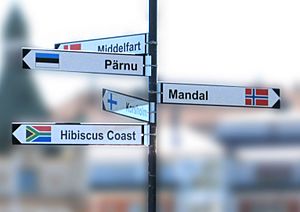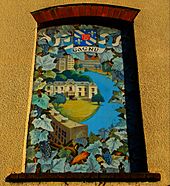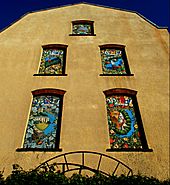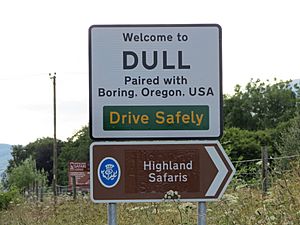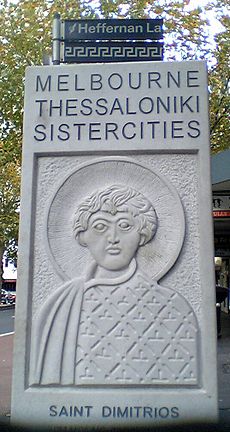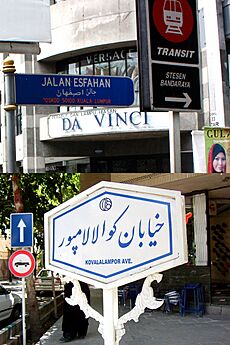Sister city facts for kids
A sister city or twin town relationship is a special agreement between two cities or towns in different countries. It's like cities becoming friends! The main goal is to build cultural and business connections. This helps people from different places learn about each other and work together.
While cities have had international links for a long time, the modern idea of sister cities really grew after World War II.
Contents
How the Idea Started
Cities have always shared ideas and cultures. But the first official sister city agreement was signed in 1931 between Toledo, Ohio (USA) and Toledo, Spain.
The modern idea of twin towns became popular during World War II. It was inspired by the heavy bombing of Coventry, England, in 1940. This event is known as the Coventry Blitz.
The mayor of Coventry, Alfred Robert Grindlay, wanted to show support for other cities that were suffering. He sent a famous message to the people of Stalingrad (now Volgograd) in 1942. This idea helped cities in allied countries feel connected during tough times.
The friendship between Coventry and Stalingrad grew stronger. During the Battle of Stalingrad, 830 women in Coventry embroidered their names on a tablecloth. They also sent money to Stalingrad. The tablecloth is now in a museum there.
Coventry and Stalingrad officially became twin cities in 1944. After the war, many more cities started similar links. This helped former enemies become friends and work for peace. For example, Coventry also twinned with German cities like Kiel in 1947 and Dresden in 1956.
Over time, the reasons for twinning expanded. Cities started twinning to encourage trade, tourism, or because they shared a name. Some even twinned due to migration links. By the 2000s, twinning also became a way for cities to build important international business connections. This can include villages, regions, or even countries.
What We Call Them
The name for these relationships can change depending on where you are. In the United Kingdom, people usually say "twin towns." In the Americas, "sister cities" is more common.
In Europe, you might hear "twin towns," "partnership towns," or "friendship towns." The European Commission calls it "town twinning."
Here are some other names:
- Spain: ciudades hermanadas (sister cities)
- Germany, Poland, Czech Republic: "partner town" or "partner city"
- France: ville jumelée (twinned town or city)
- Italy: gemellaggio (twinning)
- Netherlands: partnerstad or stedenband (city bond)
- Greece: adelphopiisi (fraternisation)
- Iceland: vinabæir (friend towns)
- Russia: goroda-pobratimy (sworn brother cities)
- China: yǒuhǎo chéngshì (friendly cities)
Sometimes, other government groups also make twinning agreements. For example, the province of Hainan in China and Jeju in South Korea have a "sister province" agreement.
The term "friendship city" might mean a more limited agreement. These are often agreements between mayors.
City Diplomacy

"City diplomacy" is when officials and people from different cities talk to each other. These cities are often in different countries. It's like international relations, but at a city level. This is different from how countries usually talk through embassies and ambassadors.
City diplomacy helps local leaders work together on problems. They focus on making life better for their residents. But they also work on big global issues, like fighting climate change.
Many groups help cities connect. These include the United Cities and Local Governments and the C40 Cities Climate Leadership Group. Even national governments see the importance of cities having their own international connections for trade, tourism, and attracting talent.
Recently, city diplomacy has grown even more. Cities are now talking directly with big international groups like the United Nations.
Twinning Beyond Cities
It's not just cities and towns that become "sisters." Provinces, states, territories, and regions also make these agreements. For example, the Canadian province of Alberta has "sister province" agreements with places like Gangwon, South Korea, and Hokkaido, Japan. These agreements can be about culture, economy, or even specific policies.
Sister Cities Around the World
The oldest known town twinning in Europe was between Paderborn, Germany, and Le Mans, France, in 836. The first modern twinning agreement was in 1920 between Keighley, England, and Poix-du-Nord, France, after World War I.
After World War II, twinning became a way to build understanding. Coventry twinned with Stalingrad and Dresden. All three cities were heavily bombed during the war. This was an act of peace. Bath in England helped the Dutch city of Alkmaar even before the war ended. Reading was the first British town to link with a former "enemy" city, Düsseldorf, in 1947.
Since 1956, Rome and Paris have been exclusively twinned. Their motto is: "Only Paris is worthy of Rome; only Rome is worthy of Paris."
The European Union supports town twinning. They have a budget to help about 1,300 projects each year. By 1995, there were over 7,000 twinning relationships in Europe.
Public art often celebrates twin town links. For example, in Sutton, England, there are murals showing its twin towns. These paintings include symbols and heraldic shields of each town.
Studies show that distance doesn't really matter when choosing a twin town. Cities often choose partners because they are similar. For example, many towns in Wales are twinned with towns in Brittany, France. Oxford is twinned with other university cities like Bonn and Leiden. Many former West German cities twinned with former East German cities before the Iron Curtain fell.
St Petersburg in Russia has the most twin city agreements in the world. In 2012, the Scottish village of Dull and the US town of Boring, Oregon, twinned to promote tourism. They played on their funny names!
Some towns even twin with fictional places. Wincanton, England, is partnered with Ankh-Morpork from Terry Pratchett's Discworld books.
Twinning is also used for business. When Nottingham City Council in the UK wanted to build a tram network, they asked for advice from their twin city, Karlsruhe, Germany. Karlsruhe has a great tram system. With their help, Nottingham finished its second tram line in 2013.
Bristol and New Orleans are working on a "tuning" partnership. This is based on their shared love for music and culture. Annecy, France, and Nerima, Tokyo, share a partnership because both have a strong animation industry.
North America
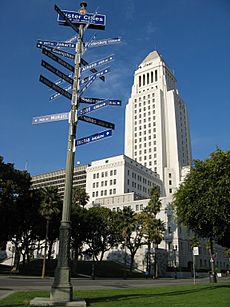
Toledo, USA, twinned with Toledo, Spain, in 1931. This was the first sister city in North America. Vancouver, Canada, twinned with Odesa, Ukraine, in 1944. This was the first in Canada.
Cities become twin towns for many reasons. Often, they have similar populations or industries. They might connect through business, travel, shared history, or communities of people who moved from one place to another.
For example, Portland, Oregon, and Bologna, Italy, twinned because they both have strong biotechnology and education industries. They also share a similar love for food! Chicago and Warsaw, Poland, connected because Chicago has a large Polish community. Indianapolis and Monza, Italy, are twinned because both cities are famous for auto racing.
In the United States, President Dwight D. Eisenhower started a citizen diplomacy program in 1956. This led to the creation of Sister Cities International (SCI).
Twin town events include the annual National Cherry Blossom Festival in Washington, D.C. This festival celebrates Washington's relationship with Tokyo City. Many twin towns also develop business agreements. For instance, Vermont's Ben & Jerry's Ice Cream company opened a factory in Russia. They offered the same profit-sharing plan to their Russian employees.
South America
Asia
China's sister city relationships are managed by the Chinese People's Association for Friendship with Foreign Countries. These initiatives are a growing way for China to connect with other countries. The number of China's sister city relationships has doubled since the early 2000s.
In Japan, the Council of Local Authorities for International Relations supports town twinning. Japan uses different terms like "Sister Cities" or "Friendship Cooperation Cities." China often uses "friendship cooperation cities" because the Chinese words for sisters can sometimes imply a higher and lower rank.
Recently, Tokyo has been actively promoting "city diplomacy" with other major global cities.
Africa
Oceania
Why Names Matter
Sometimes, cities become sisters because they have similar names. They might be named after another community, share the same name, or have names that come from the same origin. This often happens when cities share a language or were once a colony. For example, many cities named Córdoba are linked.
Images for kids
-
Louisville's twin towns
-
Twin town signs of Kemi, Finland
-
Welcome to Glastonbury, UK – Twin towns Lalibela, Ethiopia, and Patmos, Greece
-
Kragujevac and Suresnes twinning agreement
See also
 In Spanish: Hermanamiento de ciudades para niños
In Spanish: Hermanamiento de ciudades para niños


